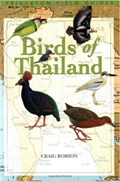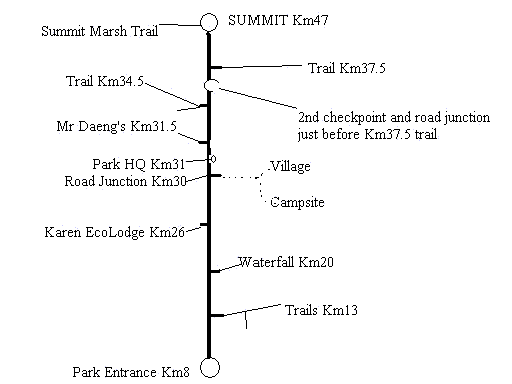
|
||||||||||
|
||||||||||
| Favorite Tweets by @thaibirding | ||||||||||
|
||||||||||
 Buy Birds of Thailand on Amazon.co.uk |
||||||||||
| Site Map ; Contributors |
| Doi Inthanon National Park, 21st - 25th April 2006 | ||
| Introduction From my base in Chiang Mai I was able to make several very productive birding trips to local national parks. Transport was by rented motorcycle, a 125cc Honda Dream from “A” Rent-a-Car along Moon Muang Road, just north of the Tha Pae Gate. There are many similar outlets in the area and competition is tough, particularly in the low season, so I was able to negotiate a rate of just 700 baht per week (about GBP 1.50 per day). A motorbike is certainly the cheapest and most convenient form of transport. Riding can be a little hair-raising in Chiang Mai city but once out on the open road the traffic rapidly diminishes. It was also very useful for reaching the substation area of Doi Chiang Dao along a very rough track which would not be passable in a 2WD car. |
||
Doi
Inthanon The main birding sites and distances along the summit road are shown below (not to scale): |
||
 |
||
I stayed at the Karen Eco-Lodge, clearly signposted at Km 26 along the summit road. Although the posted price was 400 baht per night for a basic bungalow, they gladly accepted 200 baht as the place was almost empty. Other accommodation options include bungalows at the Park HQ which were way beyond my budget. Even renting a tent and bedding to use at the campsite would have come to nearly 300 baht per night. The cheapest option is to bring your own tent. As mentioned in many previous reports, Mr Daeng’s restaurant at Km 31.5 does indeed serve excellent food, and Mr Daeng himself and the logbook at his restaurant provide all the latest info on birds seen in the area. The weather was distinctly chilly on the summit in the early morning, as low as 10 degrees Celsius. By contrast, lower areas, particularly the Km 13 trails, were very hot by late morning. Heavy showers occurred daily, particularly in the afternoons. I concentrated on birding the main sites shown on the map above, as follows: 21st April
: Summit area early morning, Km 34.5 trail late morning, Km 37.5
trail afternoon. In addition some interesting species were seen along the summit road, around the Karen Eco-Lodge, and at the Royal Gardens reached by turning left at the road fork in the village. |
||
1)
Summit and Summit Marsh trail Highlights
: Also around summit, summit marsh and last 2km of summit road : Golden-throated Barbet, White-throated Fantail, Blue Whistling Thrush, Verditer Flycatcher, Mountain Bulbul, Mountain Tailorbird, White-tailed and Blyth’s Leaf Warblers (not all phylloscs seen were identified but both species were certainly present), Rufous-winged Fulvetta, Grey-cheeked Fulvetta, and Dark-backed Sibia. I was disappointed to miss Chestnut Thrush, two of which had been reported near the warden’s kitchen at the summit. I saw no other wintering thrushes and concluded that they had probably already departed by the end of April. |
||
| 2)
Km 37.5 “jeep track” trail This trail starts just after the second checkpoint as you ascend the summit road, on the right hand side of the road almost directly opposite the road junction. There are marker posts every 100 metres along the trail to help with locating the birds mentioned in Mr Daeng’s logbook! There were many birds in here but the forest is very tall and it was frustratingly difficult to obtain good views – many more species were heard than seen. After the primary forest ended, the trail became pretty overgrown and I didn’t explore any further. Highlights : Bay Woodpecker – 1 at trail entrance Red-headed Trogon – 1 at 600m Orange-breasted Trogon – pair at 500m Short-billed Minivet – 2 White-tailed Robin – male at 150m Yellow-cheeked Tit – several Slaty-bellied Tesia – 2 Streaked Wren-babbler – pair, 400m Golden Babbler – several with bird-waves Grey-throated Babbler – 2 pairs Black-throated Sunbird - 1 Others seen : Golden-throated Barbet, Lesser racket-tailed Drongo, White-throated Fantail, Blue Whistling Thrush, Chestnut-vented Nuthatch, White-tailed Leaf Warbler, Rufous-winged and Grey-cheeked Fulvettas. |
||
3)
Km 34.5 “jeep track” trail Highlights
: The only major disappointment here was missing Purple Cochoa. Given the numbers of birds here, I reckon this trail would be the best area to look for it. |
||
4)
The summit road between Km 45 and Km 20, the Royal Gardens behind
the village at Km 30, the Karen Eco-Lodge area at Km 26 and the
waterfall at Km 20 Highlights
: Others seen : Plaintive Cuckoo, Greater Coucal, Shikra, Blue-winged Leafbird, Ashy Drongo, White-throated Fantail, Grey-headed Canary Flycatcher, Blue Whistling Thrush, Oriental and Japanese White-eye, Black-crested, Flavescent, Red-whiskered and Mountain Bulbuls, Hill Prinia, Mountain Tailorbird, Phylloscopus warblers, Fulvettas and Dark-backed Sibia. |
||
5)
Km 13 “ridge trail” Others seen : Lineated Barbet, Asian Barred Owlet, Shikra, Golden-fronted Leafbird, Greater racket-tailed Drongo, Black-naped Monarch, Black-headed, Black-crested and Sooty-headed Bulbuls, Rufescent Prinia, Dark-necked Tailorbird. |
||
Total species seen on Doi Inthanon : 100 Dominic Le Croissette |
||
| Dominic Le Croissette can be contacted at dominic@surfbirder.com | ||
| Click for more information on Doi Inthanon | Birdwatching Tours | |
 |
||

A Guide to Birdwatching in Thailand. Copyright © 2004-2017 thaibirding.com. All rights reserved.